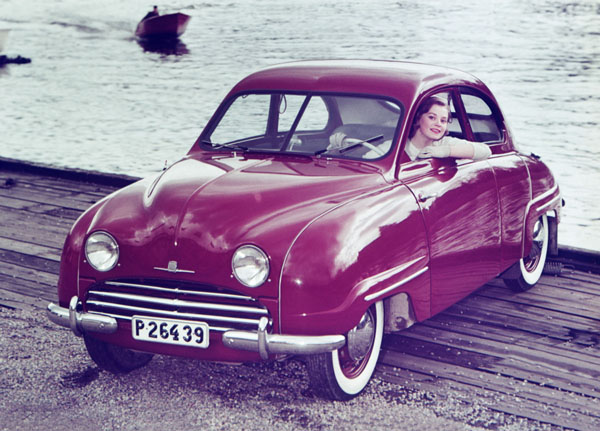
In June 1947 Saab-Scania AB unveiled its first car to an expectant public, although the first lucky owner was not to take delivery of his little green, spluttering two-stroke Saab 92 until the beginning of 1950. In terms of appearance, the 92 was an oddity, even in an era when cars generally did not feature the more modern lines typical of most present day cars. In Sweden, the streamlined, dark-green model with the stubby nose became quickly accepted.
The body consisted of a relatively small number of pressings of sheet steel, overlapped and joined by spot welds. The material used was about 20 per cent heavier than in most other cars of the same size. The construction was extremely rigid, thanks to special reinforcement sections incorporated in the design. The suspensions were attached to the shell. At the front, the assembly featured round torsion bars, mounted transversely, to which the torsional forces were transmitted by leading suspension arms in which the front wheels were supported by two ball and socket joints. The system was reminiscent of the Volkswagen suspension.
Rack and pinion steering gear was used and the turning circle was large – 11 metres – partly due to the body shape, although this was a common phenomenon in front-wheel drive models. Hydraulic drum brakes imported from lockheed of England were fitted to all four wheels, while the handbrake acted on the rear wheels only.
The water-cooled, two-cylinder, two-stroke engine with crankcase scavenging was transversely mounted, the compact length of the unit enabling the clutch and gearbox to be located alongside and driven directly from the crankshaft. As a result, all rotating shafts were parallel.
Located behind the engine, the radiator employed natural circulation and had no fan or thermostat. The muffler was located ahead of and below the engine, under the
upward curving floor pan, this location being chosen to ensure that the flat contours of the underside were not broken by any feature which would interfere with the 200mm ground clearance.
Simple as the design was, the car was not without its problems. Rumours of seized engines, corroded bearings and suspension problems spread rapidly. Leaking doors required a quick redesign of the door seals and reports of cold air leaking into the cabin of a car which had no heater in a traditionally cold country called for urgent work in collaboration with another manufacturer to produce an efficient add on heater.
The two-stroke engine did have its band of loyal supporters but Saab knew that to become an automaker of consequence, they would have to develop a four-stroke engine. After all DKW, IFA and Saab were the only automakers using 2-stroke engines in significant numbers and this was increasingly identified with small, cheap models.








